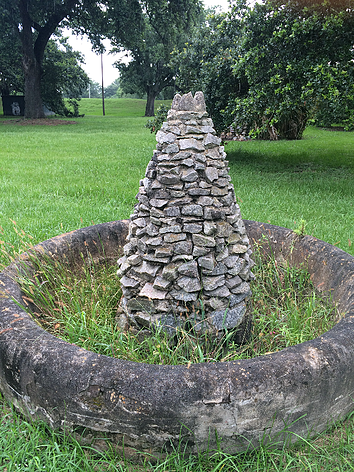In 2013, as part of FEMA’s Environmental and Historic Preservation program, archaeologists conducted a dig at the colloquially-named Spanish Fort site along Bayou St. John. I’m lucky enough to have been given an official report of the dig, which includes both historical information as well as an exhaustive inventory of discovered artifacts.
The behemoth is somewhere around 450 pages long, and much of it is incomprehensible to those of us not trained in the field. However, the artifact list is poet’s dream come true—a veritable treasure-trove of bizarre sounds, a cacophony of seemingly disparate words placed side-by-side, which, to the uninitiated, reads like nonsense delivered with utter authority. Object names—a “post-bottom mold base,” for example—could mean anything, and yet, one knows without a doubt that every object, whatever it may be, is steeped in history.
Right away, I longed to write a poem in which I pretended to be an archaeologist, so I could appropriate some of this language: a hyper-focussed, hyper-detailed sifter of history, another version of myself on hands-and-knees, troweling, brushing, labeling, gently lifting, gently rinsing (you know, all the things archaeologists do, but more whimsical and exaggerated) to find the fragments of forgotten stories.
If I were to write a poem from the perspective of my archaeologist alter-ego, here are some of the words and phrases I might use (jumbled up from the official inventory mentioned above):
grog-tempered ceramic sherds,
one rim sherd, two body sherds,
one from each stratum
ball clay pipe
pink-bodied/buff-bodied Albany slip
amber, cobalt, olive, aqua
cut nails, cut spike, soft paste
indeterminate amorphous ferrous metal
salt-glazed
indeterminate spike
slag, mortar, coquina, concrete
scalloped rim sherd like a segment
of a humpback’s fin [she adds in a metaphor]
a singular stamped pipe stem reading “BELLE/SERVE”
sliders, cooters, painted turtles
tooled bead, tooled blob, applied blob, applied brandy
applied champagne, chert pebbles
button, hinge, wire, dagger
UID bird
faunal material:
evidence of butchering: pig rib, cow patella
[1]
Ok, ok—back to the history. I learned so much from this report! Last summer, I posted about an adventure I took to the Spanish Fort, and I included photographs of conical piles of rocks (if you’ve been there, I’m sure you know what I’m talking about!) that I just couldn’t make sense of….

photo by author
*drum roll please*
The report has informed me that these are the remnants of granite rock fountains built in the late 19th century when the amusement park at the Spanish Fort site was at its zenith. Alligators in pens! Music halls and fish ponds! Carousels! Railroad cars with patrons pouring out of them! And yes, granite fountains, spilling and bubbling, day and night….
Ok, the poet has tired herself out now. I promise more history next time!
 NOLAbeings Multimedia artist Claire Bangser created NOLAbeings as a portrait-based story project that marries...
NOLAbeings Multimedia artist Claire Bangser created NOLAbeings as a portrait-based story project that marries...  Voodoo in New Orleans: Reviving history: New Orleans fortune telling This article takes a deep dive into the history of Voodoo in New Orleans, its hybridization with Catholicism, and its present-day place in the city's culture. The author visits fortune-tellers in the French Quarter, using their guidance as a tool for introspection rather than a deterministic predictor of the future. Through her experiences in New Orleans, the author feels a mystical connection to both the past and the future.
Voodoo in New Orleans: Reviving history: New Orleans fortune telling This article takes a deep dive into the history of Voodoo in New Orleans, its hybridization with Catholicism, and its present-day place in the city's culture. The author visits fortune-tellers in the French Quarter, using their guidance as a tool for introspection rather than a deterministic predictor of the future. Through her experiences in New Orleans, the author feels a mystical connection to both the past and the future. 